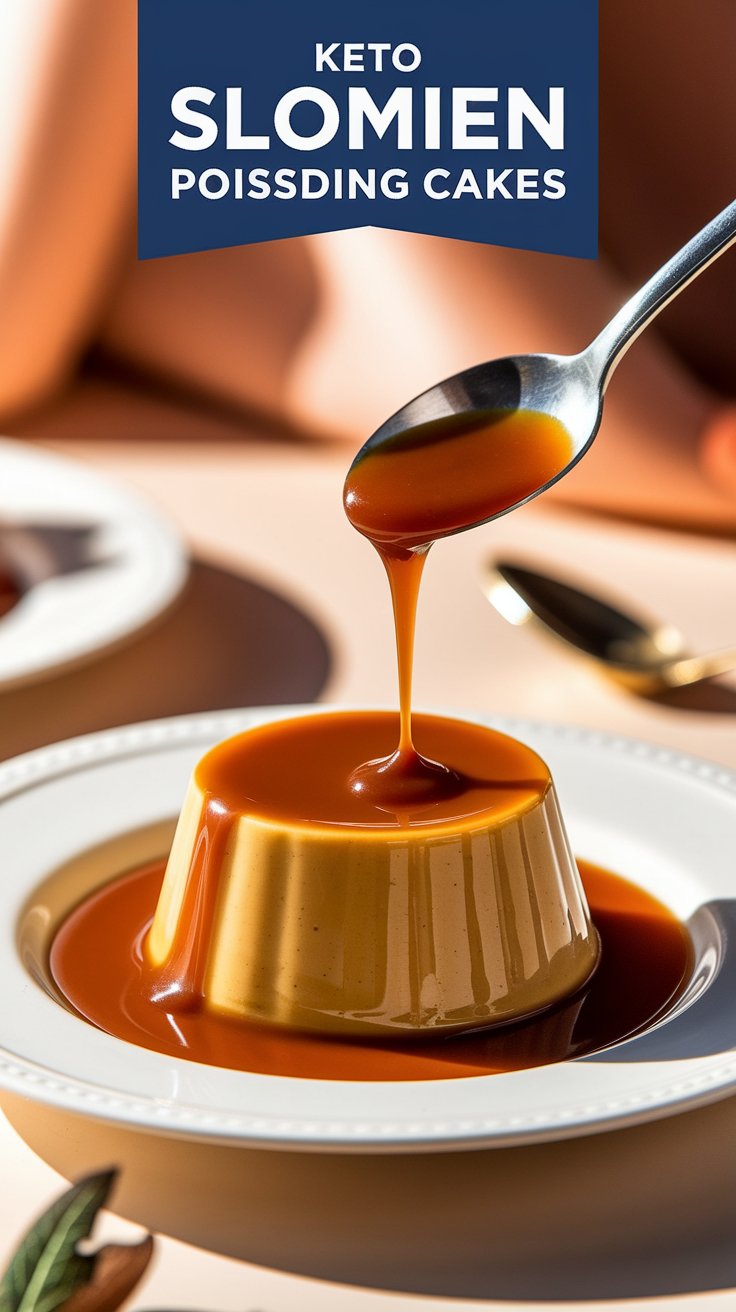Following a low-carb lifestyle doesn’t mean you have to give up indulgent desserts. In fact, some of the most refreshing and satisfying sweet treats can be created with simple keto-friendly ingredients that deliver both flavor and nourishment. Among these delights, Keto Lemon Pudding Cakes stand out as a true masterpiece—a dessert that feels sophisticated, tastes heavenly, and yet fits perfectly into a ketogenic diet.
This article is your ultimate guide to Keto Lemon Pudding Cakes. We’ll dive deep into the recipe itself, explore the health benefits of its ingredients, walk through step-by-step instructions, answer common questions, and share expert tips to help you achieve flawless results. Whether you’re an experienced baker or new to keto desserts, this guide will equip you with everything you need to master this low-carb treat.
Why Keto Lemon Pudding Cakes Deserve a Spot on Your Table
Lemon desserts have a timeless appeal. The bright citrusy zing cuts through richness and adds a refreshing lift that makes each bite feel light and vibrant. But what makes this particular recipe extra special? Let’s break it down:
- Dual Texture in One Dessert
These pudding cakes magically separate during baking—forming a light, airy cake on top and a creamy pudding layer underneath. It’s like enjoying two desserts in a single serving. - Low in Carbs, High in Flavor
With just about 4 grams of net carbs per serving, this dessert proves you don’t need sugar or flour to make something indulgent. - Perfect for Portion Control
Since the cakes are baked in individual ramekins, you can serve them elegantly at dinner parties or enjoy them as a personal treat without going overboard. - Easy to Make
Don’t be fooled by their sophisticated look. With the right technique, these cakes can be prepped and ready for the oven in under 15 minutes. - Family-Friendly Appeal
Even if not everyone in your home follows keto, this dessert is universally loved. The flavors and textures will win over kids, guests, and non-keto eaters alike.
Ingredients Breakdown and Their Keto Benefits
One of the biggest advantages of keto baking is learning how to transform simple pantry staples into gourmet creations. Here’s what you’ll need for this recipe, along with their nutritional roles:
Main Ingredients
- Eggs (3 large, separated)
Eggs are essential for structure and lift. They’re also packed with high-quality protein and healthy fats, making them a keto superfood. - Unsalted Butter (¼ cup, melted and cooled)
Butter adds richness and moisture while contributing healthy fats to keep you satiated. - Fresh Lemon Juice (⅓ cup)
Provides natural tartness and bright flavor. Lemons are low in carbs but high in vitamin C. - Lemon Zest (2 tablespoons)
The zest intensifies the citrus flavor and brings aromatic oils into the dessert without additional carbs. - Almond Flour (1 cup)
A classic keto baking staple. Almond flour is low in carbs, high in fiber, and gives structure to the cake without needing wheat flour. - Granulated Erythritol (¾ cup, divided)
A sugar substitute that sweetens without spiking blood sugar. It mimics the texture of real sugar, making it ideal for this recipe. - Baking Powder (1 teaspoon)
Provides lift and lightness to the cake layer. - Vanilla Extract (1 teaspoon)
Enhances the flavor profile and balances the tartness of lemon. - Salt (¼ teaspoon)
Just enough to bring out all the other flavors.
Optional Garnishes
- Fresh Berries (raspberries, blueberries, or blackberries)
These add color, freshness, and a touch of natural sweetness. - Whipped Cream
Lightly whipped heavy cream makes an excellent topping and complements the tang of lemon. - Extra Lemon Zest
Adds visual appeal and boosts the citrus aroma.
Step-by-Step Instructions
The key to success with Keto Lemon Pudding Cakes is in the technique—particularly when it comes to whipping egg whites and creating a gentle water bath. Follow these steps carefully, and you’ll achieve bakery-quality results.
Step 1: Preheat and Prepare
Preheat your oven to 350°F (175°C). Lightly grease 6 ramekins (about 6-ounce size) with butter or cooking spray. Place them in a large baking dish with high sides.
Step 2: Separate the Eggs
Crack three large eggs, carefully separating whites from yolks. Place the yolks in a large mixing bowl and the whites in a clean, dry medium bowl. Ensure no yolk slips into the whites, as even a trace of fat will prevent proper whipping.
Step 3: Create the Lemon Base
To the egg yolks, whisk in melted butter, lemon zest, lemon juice, and vanilla. Once smooth, add ½ cup erythritol and mix until the batter thickens slightly.
Step 4: Add the Dry Ingredients
In a separate bowl, whisk together almond flour, baking powder, and salt. Gradually fold this dry mixture into the wet ingredients until just combined.
Step 5: Whip the Egg Whites
Using an electric hand mixer, beat the egg whites on medium speed until foamy. Slowly add the remaining ¼ cup erythritol and continue beating until soft peaks form. The whites should look glossy and hold shape when the beaters are lifted.
Step 6: Fold Whites into Batter
Add one-third of the whipped whites to the lemon mixture to lighten it. Gently fold in the remaining whites in two more additions, taking care not to deflate the air bubbles.
Step 7: Fill the Ramekins
Divide the batter evenly among the ramekins, filling each about two-thirds full.
Step 8: Bake in a Water Bath
Pour hot water into the baking dish until it reaches halfway up the sides of the ramekins. Carefully transfer the dish into the oven and bake for 25–30 minutes. The tops should look golden and spring back slightly when touched, while the insides remain soft.
Step 9: Cool and Serve
Remove ramekins from the water bath. Let them cool for at least 15 minutes before serving. Enjoy warm, at room temperature, or chilled—each option offers a unique experience.
Pro Tips for Success
- Use Room Temperature Eggs: They whip better and provide more volume.
- Stick to Fresh Lemons: Bottled juice won’t deliver the same bright flavor.
- Don’t Skip the Water Bath: This ensures a creamy pudding layer forms underneath.
- Be Gentle When Folding: Avoid overmixing the egg whites, or the cake won’t rise properly.
- Cover if Needed: If the tops brown too quickly, tent loosely with foil.
- Make Ahead: Flavor deepens after chilling overnight—perfect for entertaining.
Nutritional Information (Per Serving)
Here’s a breakdown for one pudding cake (without optional toppings):
| Nutrient | Amount |
|---|---|
| Calories | 215 kcal |
| Protein | 7 g |
| Fat | 19 g |
| Total Carbs | 6 g |
| Fiber | 2 g |
| Net Carbs | 4 g |
This dessert strikes the perfect keto balance—low in carbs, moderate in protein, and rich in healthy fats to keep you satisfied.
Storage and Make-Ahead Guide
One of the best things about these pudding cakes is how well they store, making them ideal for both everyday treats and special occasions.
- Refrigerator: Store covered in the fridge for up to 5 days.
- Freezer: Once cooled, wrap ramekins in plastic wrap and foil. Freeze for up to 1 month.
- Reheating: Let chilled cakes come to room temperature for 30 minutes. If frozen, thaw overnight in the fridge before serving.
Flavor Variations to Try
While the classic lemon flavor is unbeatable, variety can make keto desserts even more fun. Here are some ideas:
- Lemon-Raspberry: Fold in fresh raspberries before baking.
- Meyer Lemon: Slightly sweeter with a floral note.
- Lemon-Lavender: Add ½ teaspoon culinary lavender for a sophisticated twist.
- Coconut-Lemon: Replace ¼ cup almond flour with coconut flour.
- Extra Tart: Use ½ cup lemon juice for a stronger citrus punch.
Common Mistakes to Avoid
- Skipping the Water Bath – Without it, you’ll end up with a dry cake and no pudding layer.
- Over-whipping or Under-whipping Egg Whites – Soft peaks are essential; too stiff or too loose won’t work.
- Using Cold Ingredients – Cold eggs or butter can cause uneven texture.
- Overbaking – The magic is in the balance of cake and pudding layers.
FAQs About Keto Lemon Pudding Cakes
Q1: Can I make this dairy-free?
Yes—swap butter with coconut oil for a slightly tropical flavor.
Q2: Can I use other sweeteners?
Yes, monk fruit or allulose work well. Adjust quantity to taste.
Q3: Can I bake it as one large cake?
Yes. Use an 8×8 inch dish (still in a water bath) and bake for 35–40 minutes.
Q4: How can I make it ahead for a party?
Bake the day before, refrigerate overnight, and serve chilled with fresh toppings.
Q5: Why didn’t my pudding layer form?
Likely issues: water bath wasn’t hot enough, ramekins weren’t filled properly, or overbaking.
Perfect Pairings
- Unsweetened whipped cream
- Fresh berries
- Sugar-free raspberry sauce
- A sprinkle of toasted almonds
- Keto-friendly vanilla ice cream
Why This Dessert Stands Out
Many keto desserts attempt to mimic high-carb classics but often fall short. These pudding cakes are different—they shine as a unique creation, not just a substitute. Their layered textures, bright lemon flavor, and elegant presentation make them versatile enough for both casual snacking and formal dining.
Unlike heavy cheesecakes or dense fat bombs, these cakes feel light and refreshing while still being indulgent. That balance is what keeps people coming back to this recipe.
Conclusion
Keto Lemon Pudding Cakes prove that you don’t need sugar or flour to create something truly delightful. With their dual layers, bright flavor, and keto-friendly nutrition, they make an excellent choice for anyone craving a dessert that feels indulgent without compromising health goals.



